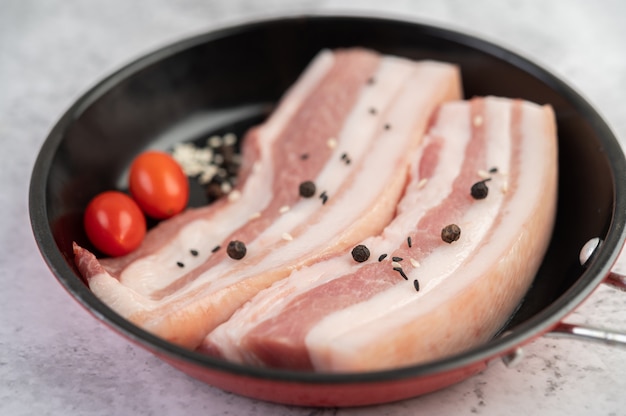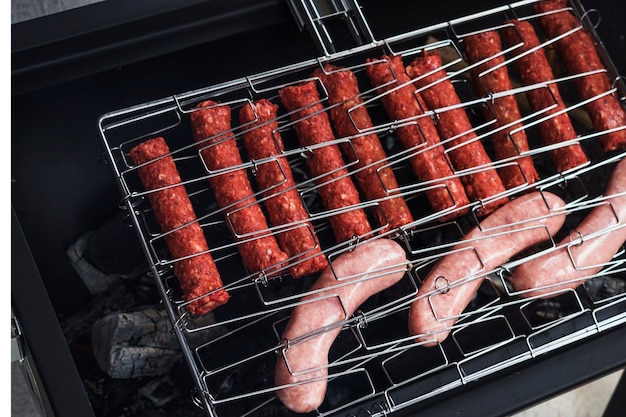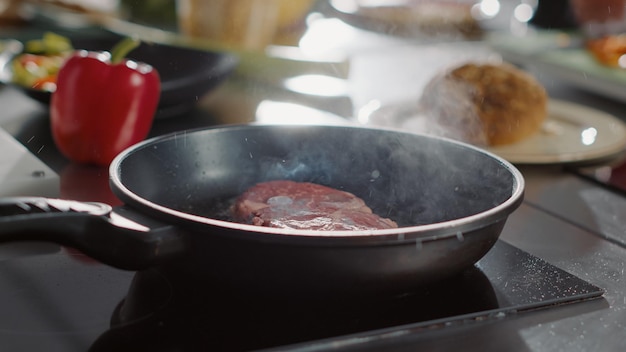Let's talk sausages. Now, you might think, "Sausages? How hard can it be to fry a sausage?" But trust me, my friend, there's an art to it. It's not just about chucking a few bangers in a pan and hoping for the best. It's about achieving that perfect golden-brown crust, that juicy, succulent interior, and that unmistakable sizzle that makes your tastebuds sing. It's about elevating the humble sausage to a culinary masterpiece.
My journey to sausage-frying mastery has been a long and winding road, filled with both triumphs and disasters. I've experimented with countless techniques, different types of pans, and even various brands of sausages. But through it all, I've learned a thing or two. So, grab a fork, settle in, and let me share the secrets I've unearthed on this epic quest for pan-fried sausage perfection.
(Part 1) The Sausage: Choosing Your Canvas

The Sausage Saga: A Quest for Quality
Before we even begin to think about pans and heat, we need to address the elephant in the room – the sausage itself. This, my friends, is where the journey truly begins. I'm not talking about those supermarket sausages that crumble into a greasy mess at the slightest touch. No, we're going for the good stuff, the real deal. We're talking about sausages that are packed with flavour, made with high-quality ingredients, and bursting with character. Think of them as the blank canvas upon which we'll create our culinary masterpiece.
When choosing your sausages, look for ones with a good meat content, ideally a blend of pork and beef. You want sausages with a bit of fat content to ensure they stay juicy and flavorful. A good sausage should have a balance of lean meat and fat, creating a textural contrast that's both satisfying and delicious. Avoid anything with too many additives or fillers – those artificial ingredients can compromise the flavour and texture of your sausage.
The Case of the Casing: Natural or Synthetic?
Now, let's delve a little deeper into the sausage's anatomy. Pay close attention to the casing. It's not just a decorative detail – it actually plays a significant role in the cooking process. natural casings, usually made from sheep intestines, are thicker and have a slightly firmer texture. They'll give you that satisfying snap when you bite into them, adding a delightful textural element to the overall experience. Synthetic casings, made from collagen or cellulose, are thinner and more pliable. While perfectly fine, they won't deliver the same satisfying bite. Ultimately, the choice is yours, but understanding the difference will help you choose the sausage that best suits your preferences.
Assessing the Sausage's Character: A Deeper Dive
Beyond the casing, consider the thickness of your sausages. Thicker sausages will take longer to cook through, so you might need to adjust your cooking time accordingly. A good sausage will have a firm but not overly dense texture, indicating a good balance of meat and fat.
Finally, don't forget to give your sausages a good sniff. A fresh sausage should have a slightly spicy aroma, hinting at the deliciousness that awaits. If it smells off, sour, or anything other than fresh and inviting, put it back on the shelf. Trust your nose – it's a reliable indicator of quality.
(Part 2) The Pan: Choosing Your Weapon

The Pan's Power: Essential for Success
Now that we have our sausage, it's time to choose our weapon – the pan. The pan you choose is crucial to achieving that perfect sear and those crispy edges. A thin, flimsy pan will buckle under the heat, leading to uneven cooking and a disappointing result. No, we need a pan that can handle the heat, distribute it evenly, and stand up to the demands of a good sausage fry-up.
Cast Iron: A Culinary Classic
My personal favourite? The cast-iron skillet. It's a culinary workhorse, known for its heat retention, even cooking, and its ability to add a hint of smoky flavour to your sausages. A cast-iron skillet heats up evenly and slowly, ensuring that your sausages cook through without burning. Plus, it's incredibly durable, lasting for generations if you care for it properly.
Stainless Steel: A Reliable Alternative
If you're not a fan of cast-iron, a heavy-bottomed stainless steel pan is a great alternative. Look for a pan with a thick base and sides, capable of holding the heat without warping. Just make sure it's thick enough to handle the heat without scorching your sausages.
Seasoning the Pan: A Ritual of Respect
Once you have your pan, it's time to season it. This is an important step in ensuring your sausages cook evenly and don't stick to the pan. Lightly grease the pan with a neutral oil, like vegetable oil or canola oil. This will create a barrier between the pan and your sausages, preventing sticking and promoting even browning.
If you're using a cast-iron skillet, you can further enhance its seasoning by heating it over medium heat for a few minutes, coating it with a thin layer of oil. This will create a protective layer on the pan that will help it last even longer and prevent rust.
(Part 3) The Heat: Master the Flame

The Temperature Tango: Finding the Right Rhythm
The heat is everything in sausage frying. Too high a heat, and you'll end up with charred exteriors and undercooked interiors. Too low a heat, and you'll be left with soggy, greasy sausages that lack any crispness. The key is to find the perfect balance, a sweet spot where the heat is hot enough to sear the sausages but not so high that it burns them.
Medium Heat: A Safe and Steady Approach
Aim for medium heat. This is usually the sweet spot for most pans and sausages. For a cast-iron skillet, you can typically use medium-high heat, but start with medium and adjust as needed. For other pans, start with medium and observe how the sausages are browning. If they're browning too quickly, lower the heat slightly. If they're not browning at all, increase the heat a little.
Testing the Heat: A Simple Trick
To test the heat of your pan, sprinkle a few drops of water onto the surface. If the drops sizzle and evaporate quickly, your pan is ready. If they just sit there and steam, it's not hot enough.
(Part 4) The Technique: The Dance of the Sausage
Avoid the Crowded Dance Floor: Give Them Space
One of the biggest mistakes people make when frying sausages is overcrowding the pan. Think of it like a dance floor – if you cram too many people in, it gets messy and no one has fun! The same principle applies to sausages. If you crowd them into the pan, they'll steam instead of browning and they won't cook evenly. Instead, give them some space to breathe. The best approach is to cook them in batches, adding more once the previous batch is nearly done. I typically cook 3 or 4 sausages at a time, depending on the size of the pan.
Searing for Perfection: The Art of Patience
Once the pan is hot and your sausages are in place, resist the urge to poke, prod, or fiddle. Let them rest undisturbed for a few minutes to develop that beautiful, crispy crust. The key is to resist the temptation to move them around too much. That golden-brown crust is the result of a slow, deliberate browning process, and any excessive movement will disrupt this crucial step.
After a few minutes, carefully flip the sausages over to cook the other side. Use a spatula to gently lift them, ensuring they don't break apart. Remember, patience is key. The more you resist the urge to constantly move them, the better the crust will be.
(Part 5) The Timing: Mastering the Clock
Cooking Time: A Balancing Act
The cooking time for your sausages will depend on their thickness and how well done you prefer them. A general rule of thumb is to cook them for about 10-15 minutes, flipping them over halfway through. However, it's always a good idea to check for doneness using a meat thermometer. A safe internal temperature for sausages is 155°F (68°C).
Don't Overcook: Respect the Sausage
Overcooked sausages can become dry and rubbery, so don't cook them beyond the point of doneness. When they're cooked through and have a beautiful golden-brown crust, they're ready to be served. Resist the temptation to keep them in the pan for too long, as they'll only dry out.
(Part 6) The Extras: Adding Depth and Delight
Flavour Boosters: Elevate the Experience
You're not limited to plain sausages, you know. You can add a touch of magic to your frying experience by incorporating a few flavour enhancers. A couple of sprigs of fresh rosemary or thyme, a diced onion, or a few slices of garlic can add a delightful depth of flavour to your sausages. However, be careful not to overdo it, as you don't want to overwhelm the natural flavour of the sausage.
Glazing for Glory: A Finishing Touch
For a truly decadent touch, consider glazing your sausages. This is where the magic of flavour and texture truly comes together. There are countless glazes you can experiment with, but I'm partial to a simple honey mustard glaze. It adds a touch of sweetness and savoury depth that complements the sausage perfectly. Just brush the glaze onto your sausages towards the end of the cooking time, allowing it to caramelize for a few minutes until it's sticky and glossy. The result is a symphony of textures and flavours that will leave you wanting more.
(Part 7) Serving Up Perfection: The Grand Finale
The Accompaniments: A Supporting Cast
Your sausages are cooked to perfection, but they need a supporting cast to truly shine. Think of it as assembling a well-balanced ensemble – the sausages are the star, but you need a supporting cast to create a harmonious and satisfying experience. Some of my favourite accompaniments for pan-fried sausages include:
- mashed potatoes: Creamy, comforting, and the perfect foil to the crispy sausages.
- Roasted vegetables: Roasted vegetables bring a delightful array of colours, textures, and flavours to the table. Think roasted root vegetables like carrots, potatoes, and parsnips, or roasted seasonal vegetables like asparagus or broccoli.
- Savoury apple sauce: A sweet and tangy sauce that provides a delightful contrast to the savoury sausages.
- green beans: A simple, crisp side that complements the richness of the sausages.
- Leafy salad: A fresh and vibrant addition to balance the richness of the sausages and their accompaniments.
- A rich gravy: A classic accompaniment that adds a touch of decadence and richness to the dish.
Ultimately, the choice of accompaniments is yours. Experiment, try different combinations, and find what you enjoy best. The key is to create a well-balanced meal that celebrates the unique flavour of the pan-fried sausage.
(Part 8) FAQs: Solving the Sausage Mysteries
1. What's the Best Way to Store Sausages?
Store your sausages in the refrigerator for up to 3-4 days. Wrap them tightly in plastic wrap or aluminum foil to prevent them from drying out. Remember, fresh is best! The longer you store them, the more flavour they will lose.
2. Can I Freeze Sausages?
Yes, you can freeze sausages for up to 2-3 months. Place them in a freezer-safe bag or container, squeezing out as much air as possible. To thaw them, transfer them to the refrigerator overnight. Just remember that frozen sausages will not be as flavorful as fresh ones. So, if possible, try to cook them within a couple of months of freezing.
3. Can I Cook Sausages in the Oven?
Yes, you can bake sausages in the oven. Preheat your oven to 375°F (190°C). Place the sausages on a baking sheet lined with parchment paper and bake for 15-20 minutes, flipping them halfway through. While oven-baked sausages won't have the same crispy exterior as pan-fried ones, they will be cooked evenly throughout.
4. What If My Sausages Are Sticking to the Pan?
If your sausages are sticking to the pan, it's likely because the pan isn't hot enough or you haven't greased it properly. Try increasing the heat slightly or adding a little more oil to the pan. You can also use a spatula to carefully loosen the sausages from the pan. If they're still sticking, it might be time to invest in a new pan – one that's seasoned properly and has a good non-stick surface.
5. Can I Cook Sausages on a Grill?
Yes, absolutely! Grilling sausages can add a smoky flavour that's truly irresistible. Preheat your grill to medium-high heat. Place the sausages on the grill and cook for 10-15 minutes, flipping them halfway through. If you're using a gas grill, use a grilling basket to prevent the sausages from falling through the grates. You can also brush the sausages with a glaze or marinade for extra flavour. Remember, the key is to achieve those grill marks, which add a delightful textural element to the sausages.
(Part 9) Conclusion: The Journey Continues
There you have it, my friends, the ultimate guide to pan-fried sausage perfection! It's not about following a rigid set of rules, but about understanding the principles of good sausage cooking and applying them to your own culinary journey. Go forth, experiment, embrace the unexpected, and discover your own unique style of sausage frying. Happy cooking!
Everyone is watching

How to Cook Frozen Lobster Tails Perfectly: A Step-by-Step Guide
RecipesLobster. Just the word conjures up images of lavish meals, special occasions, and a taste of luxury. But let's...

Pigs in a Blanket Cooking Time: How Long to Bake for Perfect Results
RecipesAh, pigs in a blanket. Just the name conjures up images of those delightful little parcels of crispy pastry en...

Pork Fillet Cooking Time: How Long to Cook It Perfectly
RecipesPork fillet, or tenderloin as it's sometimes called, is a real favourite in our house. It's so versatile, and...

The Ultimate Guide to Cooking Delicious Frankfurters
RecipesLet's face it, we all love a good frankfurter. It's a classic, simple, and always satisfying. But let's be rea...

Wolf Meat Recipes: A Guide to Cooking Wild Game
RecipesLet's be honest, you don't see wolf meat at your local butcher shop every day. It's a bit of a wild card, but ...
